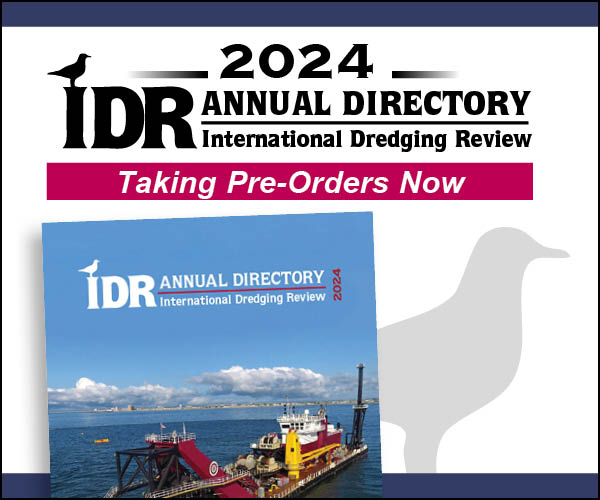DCA Presents U.S. Federal Budget and Appropriations News to WEDA Environmental Committee
By Marsha Cohen
The financial foundations of the U.S. Army Corps of Engineers and consequently the United States dredging industry are closely linked to the federal budget. This cycle of appropriations is also related to the president’s agenda. On May 23 President Trump proposed his first full budget for fiscal year 2018 and for the next ten-year cycle.
As reported by Michael Gerhardt at the Western Dredging Association (WEDA) conference in Vancouver Canada in June the president’s budget proposes $3.6 trillion in cuts and a balanced budget by 2027. Many departments including the Environmental Protection Agency the Departments of Labor State Education Agriculture and Health and Human Services are being cut hard while the Departments of Justice and of Homeland Security are securing more funds largely for border protection and defense.
Gerhardt is assistant executive director for the Dredging Contractors of America (DCA). He also serves as an industry liaison to the Council for Dredging and Marine Construction Safety and collaborates with the membership as point-of-contact for all issues concerning DCA’s Small Business and Safety and Regulatory Committees. He also serves on the board of WEDA as its Latin America chairman and president of its Eastern Chapter.
Infrastructure Budget
The budget allocates $200 billion for infrastructure spending over the next 10 years which is the most important item for the dredging industry. This is part of the $1 trillion Infrastructure Plan – with the remaining $800 billion to be sourced from the private sector. Gerhardt’s conclusion is that despite the $54 billion in cuts to non-defense discretionary accounts such as those mentioned above the U.S. Army Corps is faring well. Although the Corps’ funding is discretionary as proposed by the president it is 10 percent higher than that of the previous administration’s proposal in 2017.
That said it is important to note that the administration is in the process of re-evaluating the federal government’s role in infrastructure investment. Rather than the federal government acting as a middleman the present administration would shift the responsibilities to the states and local government for the collection of revenue and expenditure of these funds. The White House believes that federal funding is a disincentive for private sector contributions. The administration seeks a long-term change of how projects are regulated funded delivered and maintained. According to the budget they will focus federal funding on high priority transformative projects encourage self-help at the local level divest itself from certain functions that the private sector can perform better and leverage public-private partnerships.
The White House also aims to reform the environmental review and permitting process to make it more efficient. This would include developing pilot projects for analyzing less expensive ways to find how projects will enhance the environment. Agencies will be held accountable for how they review and issue permits and one agency would be created as the single responsible federal party to any single district. They would put more infrastructure permitting authority into the hands of the states and local officials and less in federal government. They would also curtail needless litigation by modifying current standards of judicial review that force agencies to spend a great deal of time and money trying to make a permit litigation-proof.
Harbor Maintenance Trust Fund
Gerhardt followed with a summary of the Corps FY18 budget including $5.002 billion for three core mission areas: coastal and inland navigation; flood risk reduction and ecosystem restoration. Some of this money comes from the Harbor Maintenance Trust Fund (HMTF). In 2017 that was $951 million and for 2018 that is increased to $965 million.
Also to be remembered is that the president’s budget must be approved by Congress and that a month after this budget was presented the American Association of Port Authorities (AAPA) reported that “Yesterday [June 30] bipartisan bicameral legislation was introduced to ensure that all Harbor Maintenance Tax (HMT) money collected is returned to ports for the maintenance of federal navigation channels and supporting maritime infrastructure.”
The Harbor Maintenance Trust Fund Reform Act of 2017 was introduced in both the House and Senate by Representatives Dave Reichert (R-WA) and Nanette Barragán (D-CA) in the House (HR 3152) and by Senators Patty Murray (D-WA) and Maria Cantwell (D-WA) in the Senate (S 1488). The Harbor Maintenance Trust Fund Reform Act of 2017 would:
• establish full use of the Harbor Maintenance Trust Fund (HMTF) each year with interest by creating a direct spending mechanism for the HMTF;
• ensure that the HMTF funds collected are allocated fully and more equitably by establishing a set-aside for donor ports;
• address the issue of cargo diversion by increasing investments to donor ports to provide rebates to shippers transporting cargo through their ports or for port infrastructure needs; and
• support operation and maintenance at small ports and harbors by updating the baseline for the set-aside for small ports.
According to Jim Walker at AAPA HMTF generates about $1.6 billion annually which is considered sufficient to fully fund harbor maintenance needs. Five years ago only about half the annual HMT revenue was going to the Corps and being used for its intended purpose. The Water Resources Reform and Development Act signed by the previous administration in December 2016 established funding targets that if followed would lead to full HMFT revenue use by the Corps in 2025. This proposed legislation would make full revenues immediately available.
Passage of the Harbor Maintenance Trust Fund Reform Act of 2017 will have positive impact on funding the Corps for investigations construction and operations and maintenance to improve the waterways infrastructure of the United States Gerhardt said. This in turn should have a direct and positive impact on the domestic dredging industry



